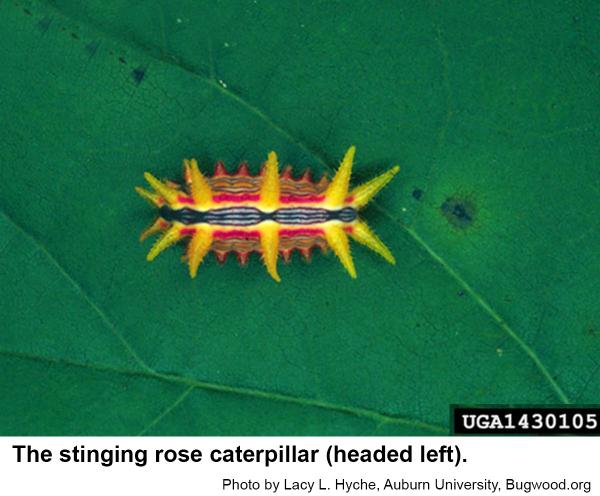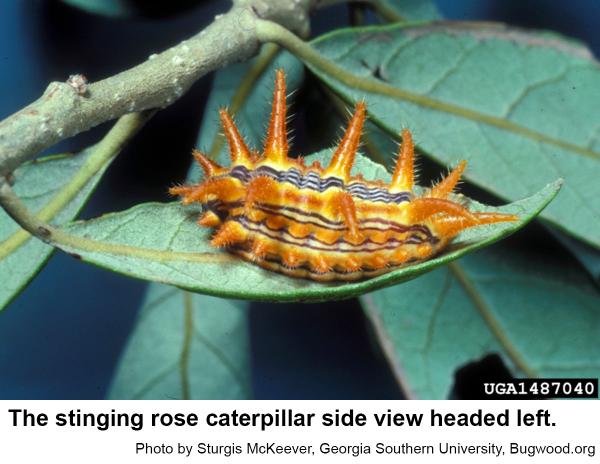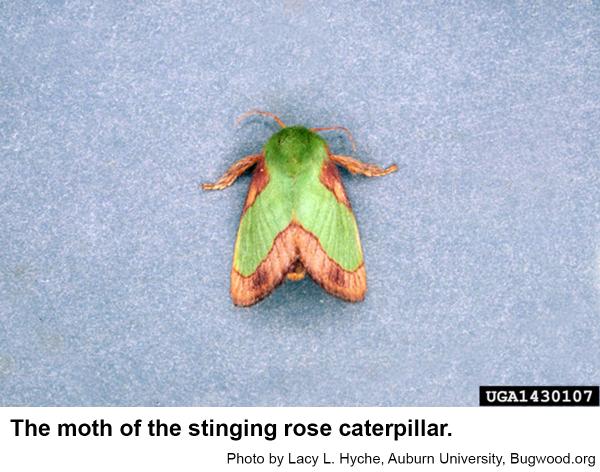Description and Biology
The stinging rose caterpillar, Parasa indetermina, is in a family of stinging caterpillars. The fully grown caterpillar is slightly less than an inch long, but causes a sting way out of proportion to its size! This caterpillar has seven pairs of spine-covered “horns” as well as smaller spiny bumps along each side. Each spine is hollow and filled with a urticating fluid. When the spine brushes against human skin, the tip breaks off and releases the offending fluid, which causes a painful sting. That spot eventually swells and remains painful for hours or days. The stinging rose caterpillar also has white, black, orange and red lines running along the back and sides. Female and male moths emerge in mid summer, mate, and females lay eggs from which tiny caterpillars hatch. The moths are green with brown patches on the wings. As the caterpillars feed, molt, and grow they usually hide on the lower surface of their host plant leaves. In later summer, each caterpillar spins a tough brown capsule-like cocoon inside of which they spend the fall, winter, and spring. Sometime during that time the caterpillar molts into a pupa from which the moth develops.
Host Plants
Stinging rose caterpillars feed on apple, bayberry, cherry, chestnut, dogwood, hickory, maple, oak, paw paw, pear, plum, poplar, and rose. Although they have a broad host range, this is a somewhat rare species.
Residential Recommendations
Since stinging rose caterpillars are relatively rare, perhaps the best control is to dislodge the insect and trample it under foot. Most insecticides labeled for landscape use should give more than adequate control during the growing season.
References
- Beautiful Danger: the Stinging Rose Caterpillar, colorful, cool, insect, Parasa indetermina. Brooke, C. 2012. Featured Creature.
- Conservation Assessment for the stinging rose caterpillar (Parasa indetermina Boisduval). Bess, J. 2005. USDA Forest Service, Eastern Region. 33 pp.
- The Rose Slug-Caterpillar. Chittenden, F. H. 1913. USDA Bureau of Entomology Bulletin No. 124. 9 pp.
- Stinging rose caterpillar, Order: Lepidoptera, Family: Limacodidae, Genus and species: Parasa indetermina (Boisduval). Barnes, J. K. 2004. University of Arkansas Arthropod Museum, Arthropod Museum Note Number 29.
- Extension Plant Pathology Publications and Factsheets
- Horticultural Science Publications
- North Carolina Agricultural Chemicals Manual
For assistance with a specific problem, contact your local Cooperative Extension Center.
This Factsheet has not been peer reviewed.
Publication date: April 11, 2016
Reviewed/Revised: Oct. 15, 2019
Recommendations for the use of agricultural chemicals are included in this publication as a convenience to the reader. The use of brand names and any mention or listing of commercial products or services in this publication does not imply endorsement by NC State University or N.C. A&T State University nor discrimination against similar products or services not mentioned. Individuals who use agricultural chemicals are responsible for ensuring that the intended use complies with current regulations and conforms to the product label. Be sure to obtain current information about usage regulations and examine a current product label before applying any chemical. For assistance, contact your local N.C. Cooperative Extension county center.
N.C. Cooperative Extension prohibits discrimination and harassment regardless of age, color, disability, family and marital status, gender identity, national origin, political beliefs, race, religion, sex (including pregnancy), sexual orientation and veteran status.



